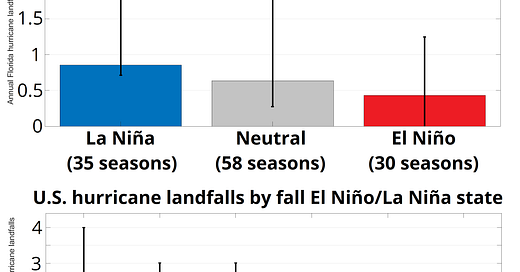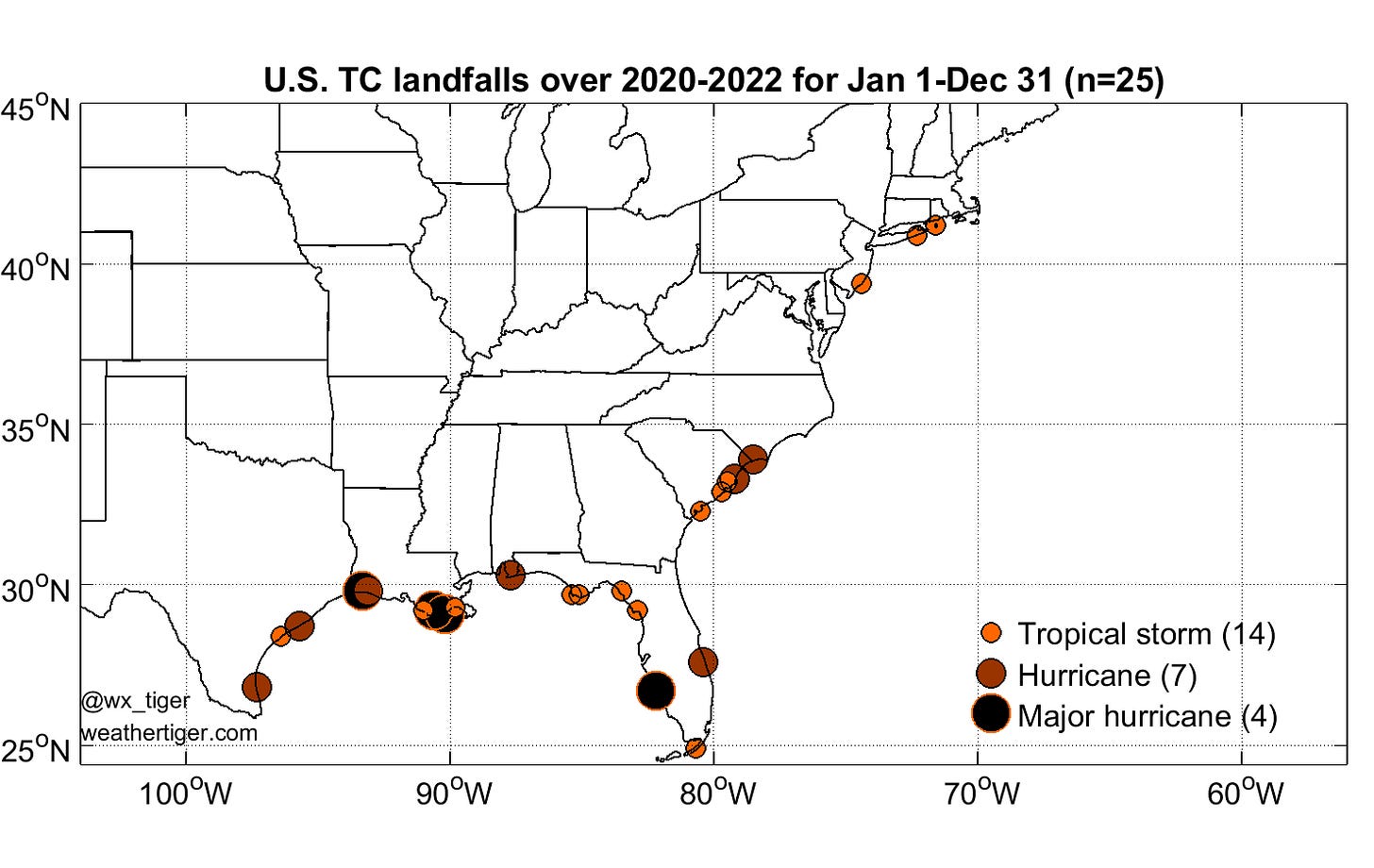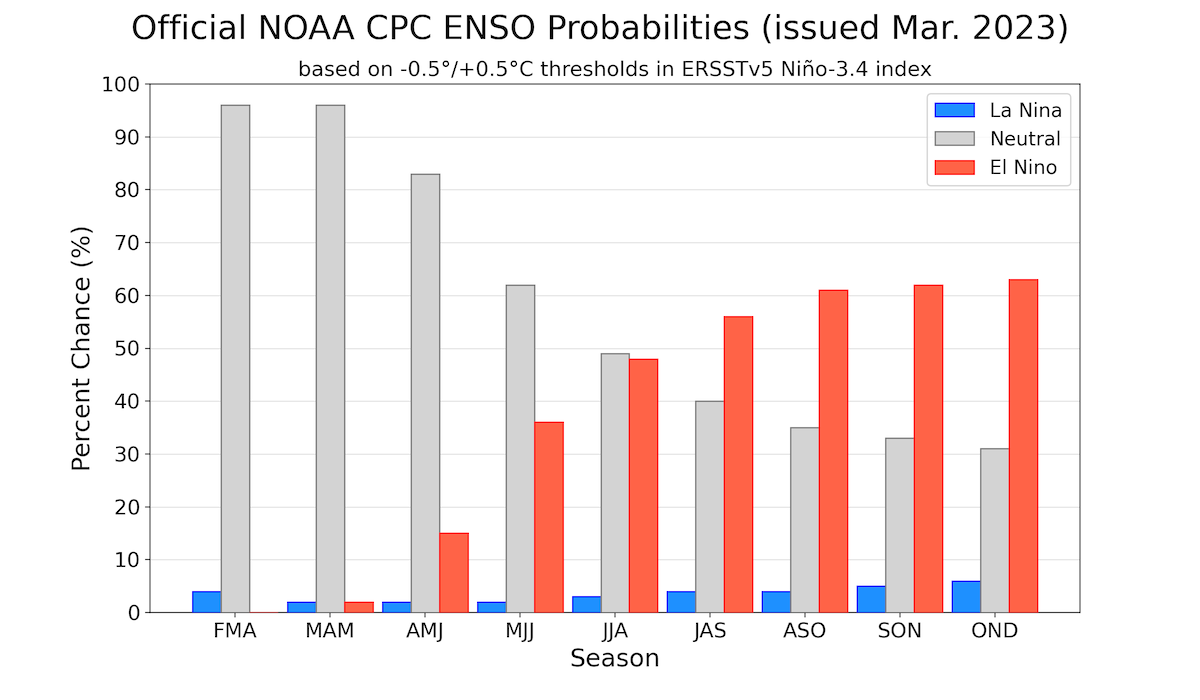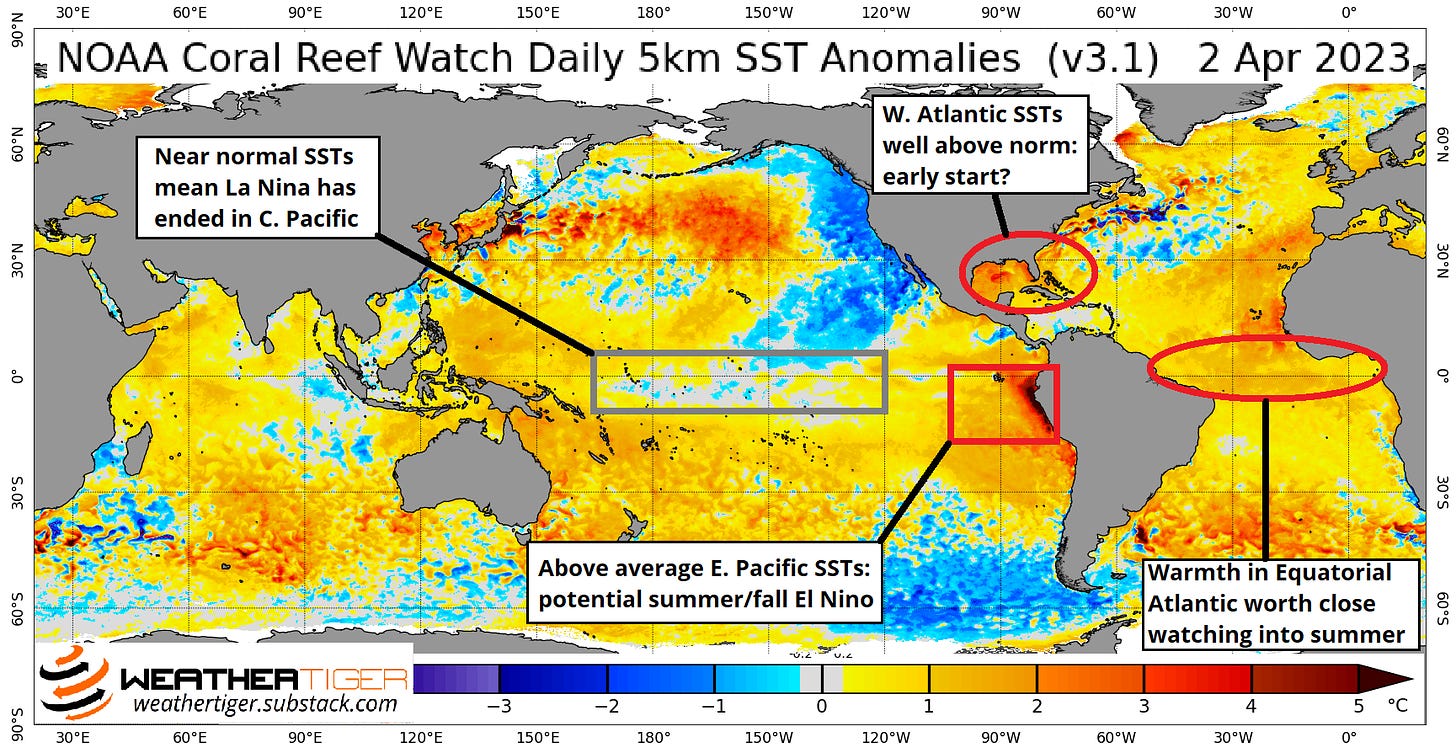Atlantic Hurricane Season First Look for April 2023
La Niña's demise potentially sets up a quieter 2023 Atlantic hurricane season, but complications loom.
A little more than three years ago, as sports bar TVs were split between coronavirus infection tallies and the XFL, a more subtle but no less x-treme scourge was taking shape across the tropical oceans.
La Niña, defined by colder than normal sea surface temperatures (SSTs) in the Central Pacific, developed in the summer of 2020. Since then, as everything else has changed other than the 99-cent price of AriZona iced tea, global weather patterns have consistently been in the thrall of the third-longest Niña on record. Like the world’s worst gender reveal, the 2020-23 La Niña’s résumé included staggering drought in the Plains and Florida’s “winters” lasting around 4 days.
In the Tropics, La Niña also fomented the busiest three-year period for the continental U.S. since the 1930s1, with a total of 25 (!) tropical storm, eleven hurricane, and four major hurricane strikes. In each of the 2020, 2021, and 2022 seasons, the Gulf Coast suffered a catastrophic Category 4 hurricane landfall, culminating with Ian’s $113 billion lapidation of Southwest Florida.

And yet, with the demise of La Niña this March, an unfamiliar feeling hides in the corner of the Pandora’s Box that is hurricane season: hope.
WeatherTiger’s initial forecast for the 2023 Atlantic season holds out around a 70% chance of normal or below normal tropical activity in the year ahead, projecting a most likely outcome of around 90-95% of 1950-2022 averages. This corresponds to odds of a below normal (<75 Accumulated Cyclone Energy units), normal (75-125 ACE), or above normal (>125 ACE) season of about 35%, 35%, and 30%, respectively. The ’23 season has a 50-50 shot of landing somewhere between 65-135 ACE units, 13-18 tropical storms, 5-8 hurricanes, and 2-3 major hurricanes.
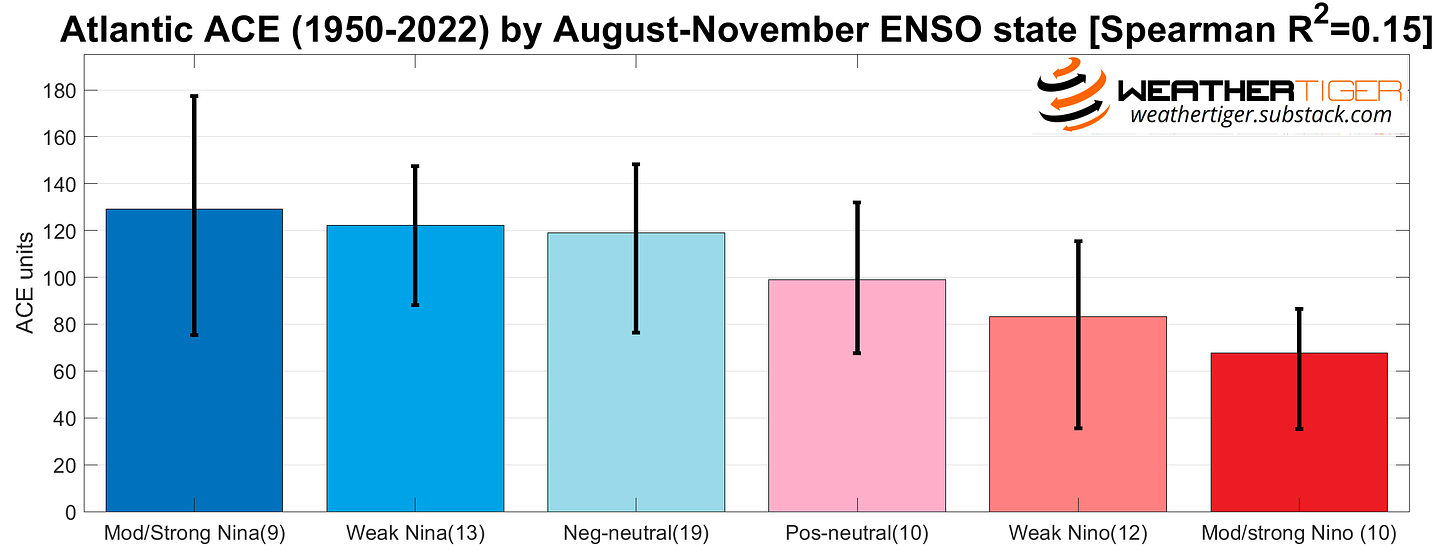
The reason for this cautious optimism is that Atlantic hurricane activity has a strong relationship with the multi-year cycle of abnormally warm (El Niño) or cool (La Niña) waters in the Equatorial Pacific known as the El Niño-Southern Oscillation (ENSO). As summer and fall El Niños are often linked to hurricane-weakening wind shear in the Atlantic, La Niña hurricane seasons average about 75% more tropical activity than El Niño years.
The disparity is even more stark in terms of what really matters, stronger storms impacting land. In Florida, La Niña seasons since 1900 have notched an average of 0.8 hurricane landfalls per year, compared with around 0.4 hurricane landfalls per year during El Niños. Roughly doubled hurricane risks in La Niña versus El Niño seasons, with neutral years somewhere in the middle, holds true for U.S. landfalls as well.
Unfortunately, spring ENSO projections face a “predictability barrier” of diminished forecast skill due to the susceptibility of the Pacific to sudden shifts. In 2023, the ENSO outlook is a riddle wrapped in an enigma, like the bizarre names found on the backs of the original XFL uniforms, including those of the Orlando Rage.
In the past month, SSTs in the Central Pacific have returned to near-normal after three years of cool anomalies, while the waters of the Eastern Pacific have surged warmer, which sometimes presages El Niño development. The official ENSO forecast from the National Weather Service has about a 60% chance of El Niño arriving by the peak of hurricane season in September.
That’s not the whole story, though. Many sophisticated computer models that simulate the ocean-atmosphere system are going wild, calling for a much faster emergence of strong El Niño conditions by summer. Most “dynamical” models initiate El Niño by August or September. That is all well and good, as the stronger and earlier the Niño, the greater the historical probability of a quieter Atlantic hurricane season.
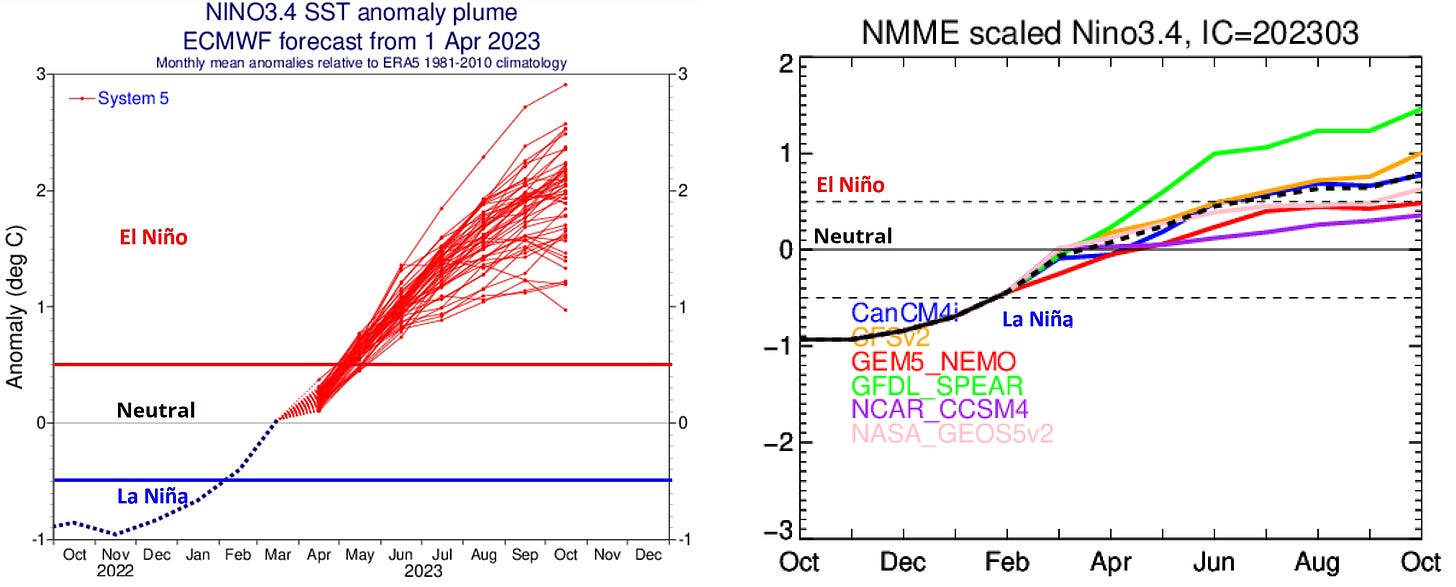
However, the dynamical guidance has had a distinct pro-Niño bias in other recent springs. In April 2017, several of these models called for a super El Niño by summer; in reality, a weak La Niña developed in the fall, and the Atlantic hurricane season was one of the most active on record. Statistical ENSO models, like WeatherTiger’s own, are projecting either the slow development of a weaker Niño by fall or winter, or persistent warm-neutral conditions that fall short of Niño status. Still, April is the timeframe of the biggest gap between dynamical and statistical ENSO model skill, so all projections should be taken with some big grains of salt.
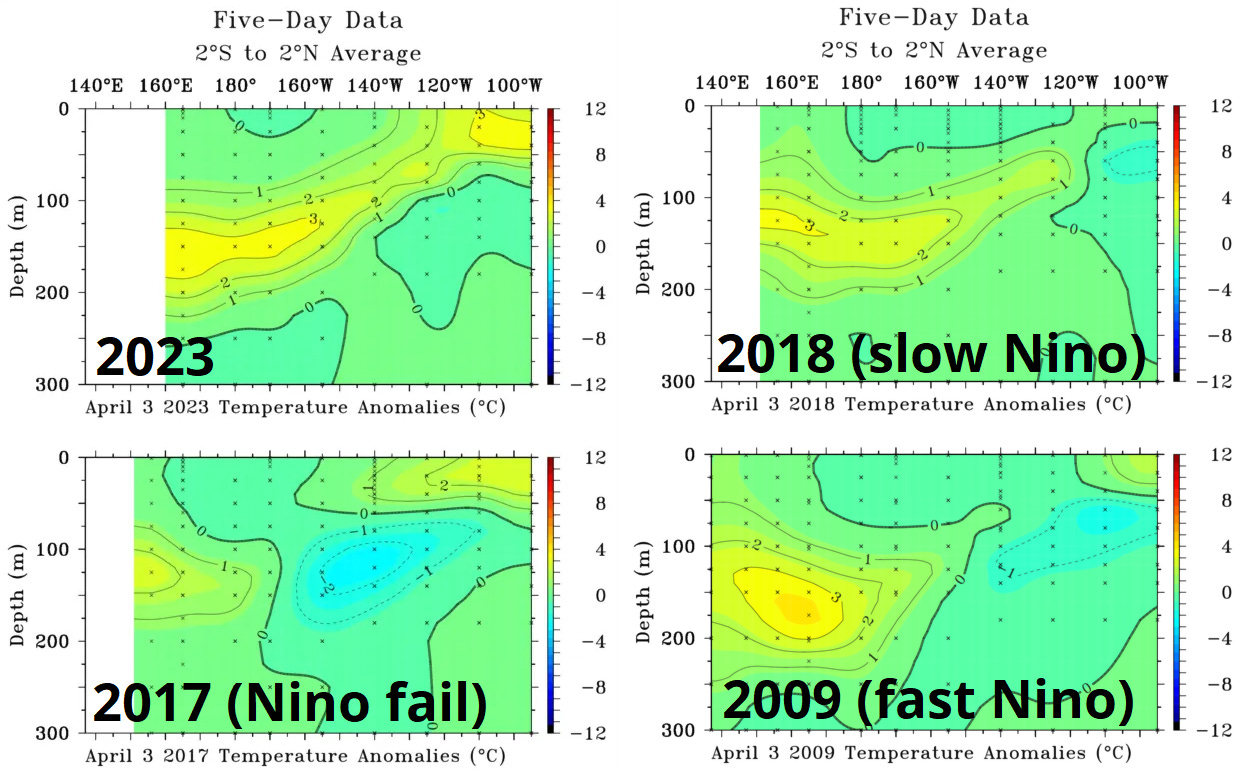
Probably the single most compelling argument for the eventual emergence of an El Niño this year is what’s going on under the hood in the Pacific. A deep dive into temperature anomalies of the Equatorial Pacific finds a large pool of waters 2-5°F warmer than normal lurking a couple hundred meters beneath the waves. This configuration, which primes warmer sea surface temperature to emerge in the Pacific when tropical trade winds weaken or reverse, is similar to the subsurface warmth in other recent, quiet years like 2009 in which an El Niño developed during hurricane season. Despite model enthusiasm in 2017, as seen above, submerged spring warmth was missing from the Pacific, presaging a notable bust for ENSO dynamical models.
Still, even Pacific warm pools aren’t the be all and end all for U.S. hurricane risks. The 2023 warm pool is also reminiscent of spring 2018, a year in which a modest El Niño gradually developed by late September. To be fair, the 2018 El Niño did shut down tropical activity in the Gulf and Caribbean in mid-October… right after a monster Category 5 hurricane slammed the Panhandle.
The point is El Niño making bad outcomes somewhat less likely does not eliminate the chance of catastrophic impacts. This is Florida, and hurricane risks will be with us far more than 21 years after the death of the final offspring of the last Cavalier King Charles Spaniel owned by the youngest descendant of King Charles III. Like the XFL, there are no hard-and-fast rules in seasonal hurricane prediction, just general guidelines.
The next six weeks will determine a great deal, and models are currently split on the extent to which weaker trade winds will drive the Pacific out of neutrality and into a more El Niño-like state in the near future. In the meantime, another key consideration is Atlantic SST anomalies. Historically, the strongest relationships between Atlantic spring warmth and an active hurricane season are found between eastern Brazil and West Africa. Warm spring waters there often migrate north into the Atlantic’s Main Development Region by the hurricane season’s peak, promoting more frequent development of tropical waves.

This spring, water temperatures in the eastern Atlantic are well above normal, and more broadly, areas with a positive relationship between spring SSTs and a more active hurricane season are significantly warmer than normal. This isn’t too surprising as the North Atlantic is the hottest it has ever been for early April, and again, those relationships are still weak this far away from the season. However, unseasonable Atlantic heat more typical of mid-May further ups the stakes of El Niño actually developing, as there’s no indication of Atlantic SSTs being unfavorable to hurricanes in 2023.
Finally, while they are not meaningful predictors of seasonal activity, the Gulf and southwestern Atlantic already cracking the 80°F threshold probably augurs yet another early onset to hurricane season. Seven of the past eight years have featured a named storm prior to the official start of the season on June 1, with Tropical Storm Watches issued for Florida on June 2 in the sole laggard, 2022. The National Hurricane Center will start seven-day tropical outlooks on May 15, though I wouldn’t be shocked if even that doesn’t capture the opening act of the 2023 season.
Overall, reports of El Niño’s arrival may be exaggerated, but a range of outcomes remain in the realm of the possible for 2023 Atlantic TC activity. With the ENSO conundrum front and center, forecast skill at this lead time is relatively low, only about 30% better than climatology. If a moderate or strong El Niño develops, there is the potential for the elusive “rebuilding season” in the Atlantic. However, if El Niño dawdles or is a no-show, spring conditions are otherwise generally supportive of normal or above normal Atlantic TC and U.S. landfall activity in 2023.
There are signs of hope as hurricane season approaches, but reasons for caution as well. El Niño is not a certainty, the Atlantic is absurdly warm, the bank where Mavis Beacon has her checking account collapsed, and while the sample size is a scant two, it troubles me that the other years with XFL seasons— 2001 and 2020— were also not the best, generally speaking.
I’ll be back with an updated seasonal outlook in late May, with bulletins until then as conditions warrant. Keep watching the skies.
In terms of ACE occurring over the continental U.S., with 2020-2022 U.S. ACE of ~33.5 units exceeded since 1900 only by 1933-1935 U.S. ACE of ~35 units.

